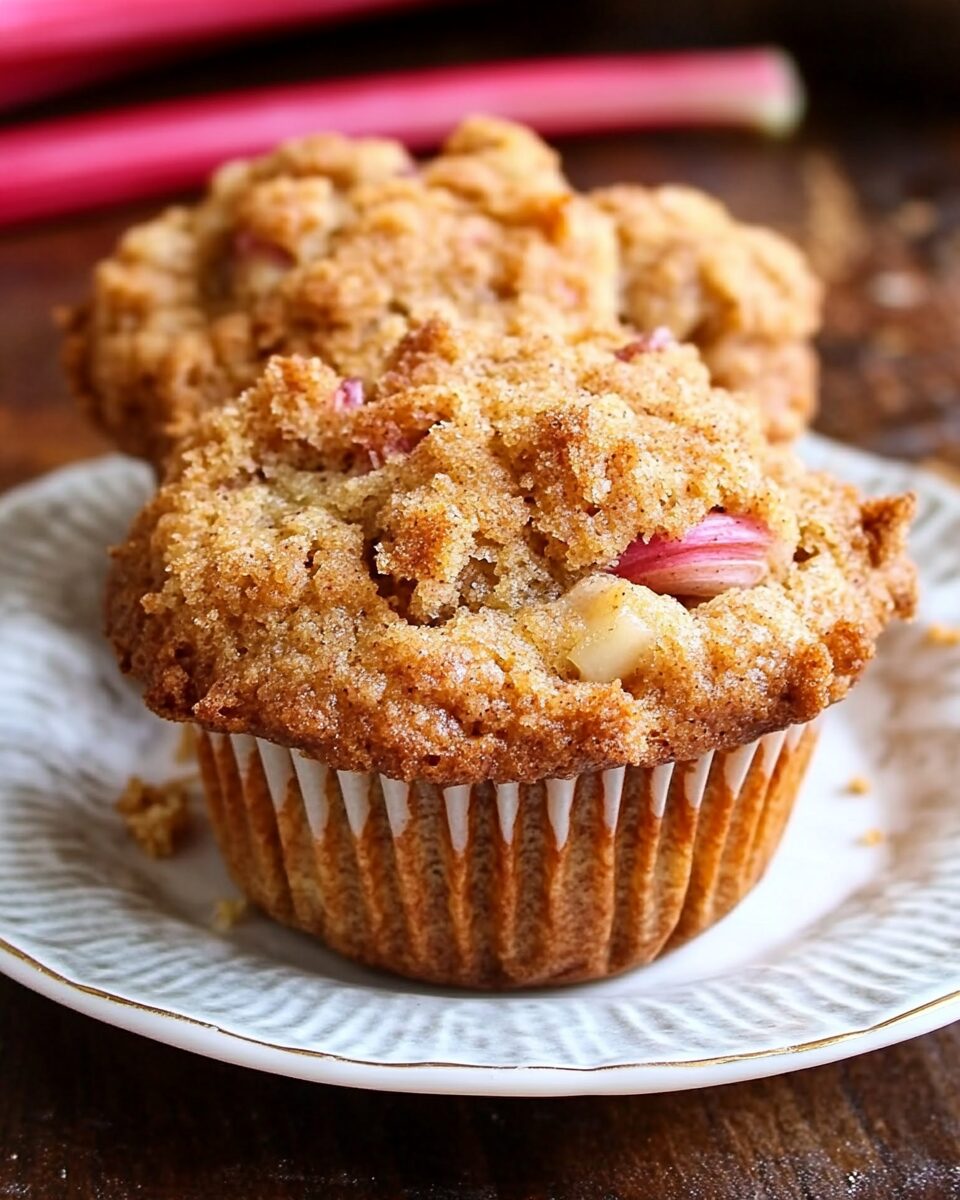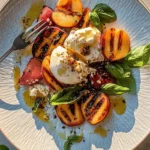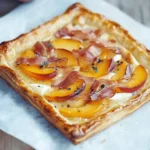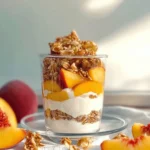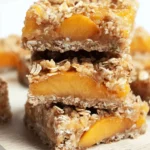These cinnamon-topped rhubarb muffins are a nostalgic treat, packed with tart rhubarb and a sweet, spiced crumb topping. Perfect for breakfast or an afternoon snack, these moist and tender muffins bring a cozy, homemade flavor straight from grandma’s kitchen.
FULL RECIPE
Ingredients
- 2 cups all-purpose flour
- 3/4 cup granulated sugar
- 2 1/2 tsp baking powder
- 1/2 tsp baking soda
- 1/2 tsp salt
- 1 large egg
- 3/4 cup milk
- 1/3 cup vegetable oil
- 1 tsp vanilla extract
- 1 1/2 cups chopped fresh rhubarb
1.Topping
- 1/3 cup packed brown sugar
- 1/2 tsp ground cinnamon
- 1 tbsp butter, melted
Directions
- Preheat oven to 375°F (190°C). Line a muffin tin with paper liners or grease well.
- In a large bowl, whisk together flour, sugar, baking powder, baking soda, and salt.
- In another bowl, beat egg, then mix in milk, oil, and vanilla.
- Stir wet ingredients into dry ingredients until just combined; do not overmix.
- Fold in chopped rhubarb gently.
- Divide batter evenly among muffin cups, filling each about 3/4 full.
- In a small bowl, mix brown sugar and cinnamon. Stir in melted butter until crumbly.
- Sprinkle topping evenly over muffin batter.
- Bake for 20–25 minutes, or until a toothpick inserted into the center comes out clean.
- Cool muffins in pan for 5 minutes, then transfer to a wire rack to cool completely.
Nutritional Information
- Calories: 190
- Fat: 7g
- Carbohydrates: 30g
- Sugar: 14g
- Protein: 3g
- Fiber: 1g
History and Origin of Rhubarb Muffins
Rhubarb muffins have a long-standing tradition in many households, especially in regions where rhubarb grows abundantly during spring and early summer. The tartness of rhubarb combined with sweet muffin batter reflects a classic balance cherished in baking for generations. Originating from European recipes, rhubarb muffins became popular in North America as settlers adapted local ingredients to familiar baking styles. This particular cinnamon-topped version adds a comforting spice twist that enhances the natural tartness of rhubarb.
Nutritional Benefits of Rhubarb
Rhubarb is a vegetable often treated as a fruit in baking. It is low in calories and contains important nutrients such as vitamin K, vitamin C, and fiber. Its tart flavor is due to organic acids, which also contribute to its potential antioxidant properties. Incorporating rhubarb into muffins not only adds a unique taste but also boosts the nutritional profile of the baked good.
The Role of Cinnamon in Baking
Cinnamon is a spice that pairs wonderfully with the tartness of rhubarb. It adds warmth and depth to the flavor profile of the muffins. Beyond taste, cinnamon has been noted for its anti-inflammatory and antioxidant properties, making it a flavorful and healthful addition to baked goods.
Why Use Baking Powder and Baking Soda Together?
This recipe uses both baking powder and baking soda, which serve different purposes in leavening. Baking powder contains acids and bases that react to moisture and heat, providing lift. Baking soda requires an acid to activate, and rhubarb’s natural acidity helps trigger this reaction, making the muffins light and tender.
Choosing the Right Flour for Muffins
All-purpose flour is ideal for these muffins because it offers a balance of protein that results in a good crumb without being too dense or too light. Using cake flour or whole wheat flour would change the texture and possibly the flavor, either making the muffins softer or denser.
The Importance of Not Overmixing Muffin Batter
Overmixing can develop gluten in the flour, resulting in tougher muffins. The gentle folding of ingredients preserves tenderness and allows the muffins to rise evenly. This technique is crucial in achieving the soft, moist crumb characteristic of quality muffins.
The Effect of Oil Versus Butter in Muffins
Using vegetable oil instead of butter contributes to a moist texture and longer shelf life. Oil remains liquid at room temperature, keeping the muffins soft and preventing them from drying out quickly, which is ideal for baked goods meant to be enjoyed over several days.
Fresh Versus Frozen Rhubarb
Fresh rhubarb is preferred for its bright flavor and firm texture, but frozen rhubarb can be used if fresh is unavailable. Frozen rhubarb should be thawed and drained to prevent excess moisture from affecting the muffin batter and texture.
The Science Behind the Cinnamon Sugar Topping
The cinnamon sugar topping provides a delightful contrast of sweet and spice with a slight crunch. The butter in the topping helps the sugar and cinnamon adhere to the muffins, creating a caramelized layer when baked that enhances both flavor and texture.
How to Store Rhubarb Muffins
To maintain freshness, store muffins in an airtight container at room temperature for up to two days. For longer storage, muffins can be refrigerated for up to a week or frozen for several months. Wrapping them individually before freezing helps preserve moisture and flavor.
Serving Suggestions for Rhubarb Muffins
These muffins are versatile and can be served warm or at room temperature. They pair well with butter, cream cheese, or a light drizzle of honey. They make a perfect breakfast treat or an afternoon snack with tea or coffee.
Customizing the Recipe
You can experiment by adding nuts like walnuts or pecans for crunch, or incorporate spices such as nutmeg or ginger alongside cinnamon to deepen the flavor. Adjusting the sugar in the batter can also tailor sweetness to your preference, especially if your rhubarb is very tart.
Common Mistakes to Avoid
A common mistake is adding too much rhubarb, which can make muffins soggy and affect rising. Another is overbaking, which dries out the muffins. Keeping an eye on the baking time and sticking to the recipe’s quantities ensures optimal results.
Gluten-Free Adaptations
For those avoiding gluten, this recipe can be adapted by substituting all-purpose flour with a gluten-free flour blend that includes xanthan gum. However, texture may vary slightly, and baking times might need slight adjustment.
The Role of Vanilla Extract
Vanilla adds a subtle sweetness and rounds out the flavors, complementing both the rhubarb and cinnamon. It enhances the overall aroma and complexity without overpowering the primary ingredients.
How Seasonal Availability Affects the Recipe
Rhubarb is typically available in spring and early summer. Baking these muffins during rhubarb season ensures fresh, flavorful fruit. Outside this time, frozen or canned rhubarb can be used, but fresh rhubarb provides the best texture and flavor.
The Cultural Significance of Rhubarb in Cooking
Rhubarb holds a nostalgic place in many cultures, especially in Northern and Eastern Europe. Its use in pies, crumbles, and muffins is often linked to family traditions and seasonal celebrations. The balance of tartness and sweetness in rhubarb dishes makes it a favorite comfort food.
The Environmental Impact of Using Local Ingredients
Using locally sourced rhubarb reduces the environmental footprint associated with transportation and storage. Supporting local farmers not only helps the community but often results in fresher, more flavorful produce for baking.
Adapting Muffins for Dietary Preferences
These muffins can be modified to fit vegan or dairy-free diets by substituting milk with plant-based alternatives and using flax or chia eggs instead of chicken eggs. These adaptations allow more people to enjoy the recipe without compromising too much on taste or texture.
Pairing Rhubarb Muffins with Beverages
The tart and sweet flavors pair well with a variety of drinks. Black coffee or chai tea highlights the spice, while a fruity herbal tea can complement the rhubarb. For a brunch setting, sparkling water with a splash of citrus adds a refreshing contrast.
Conclusion
Cinnamon-topped rhubarb muffins combine the tart freshness of rhubarb with the comforting warmth of cinnamon, resulting in a delightful baked good that is both flavorful and nostalgic. This recipe’s careful balance of ingredients and attention to technique make it accessible for bakers of all skill levels, while allowing room for creative customization. Whether enjoyed fresh in spring or adapted for year-round baking, these muffins offer a satisfying treat that honors tradition and taste alike.

